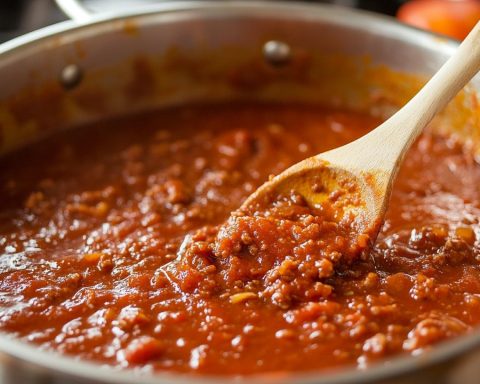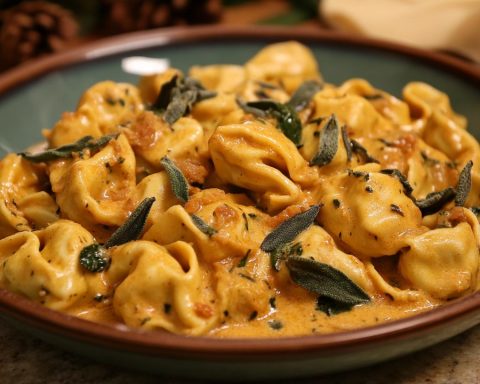Step into the enchanting world of Asturian culinary tradition with Fabada Zupa, a robust bean stew that warms you from the inside out. Born in the lush, verdant hills of northern Spain, this sumptuous dish is a comforting embrace on a chilly evening, a celebration of both simplicity and decadence. Its roots deeply embedded in the rustic landscape, fabada is a testament to the art of slow cooking, a method that draws out the rich, smoky flavors of its ingredients with patience and love. With its deep complex flavors, this dish offers a delightful dance between tender white beans, savory chorizo, and the earthy allure of morcilla (Spanish blood sausage).
This dish is not just a feast for the palate but also a bowl brimming with nutrition, offering more than just warmth and flavor. A serving of about one cup generally contains around 420 calories and is packed with protein and fiber, making it a satisfying meal that keeps you feeling full and energized. Fabada Zupa is as perfect for a festive family gathering or a quiet evening by the fire as it is for providing a filling, nutritious comfort during the cool months.
Ingredients:
– 1 pound dried fabada beans or cannellini beans, soaked overnight
– 2 tablespoons olive oil
– 1 large onion, finely chopped
– 3 garlic cloves, minced
– 1 teaspoon sweet smoked paprika
– 2 bay leaves
– 7 ounces Spanish chorizo, sliced
– 7 ounces morcilla (Spanish blood sausage), sliced
– 1 ham hock
– 1 teaspoon saffron threads
– Salt and black pepper, to taste
– 4 cups chicken stock or water
– Fresh parsley, chopped (for garnish)
– Crusty bread, for serving
Instructions:
1. Prepare the Beans:
– After soaking the beans overnight, drain and rinse them thoroughly. Set aside while you prepare the rest of the ingredients.
2. Begin the Flavor Base:
– In a large, heavy bottomed pot, heat the olive oil over medium heat. Add the chopped onion and sauté until translucent, about 5 minutes. Add the garlic and cook for another minute, taking care not to burn it.
3. Infuse with Spice:
– Stir in the smoked paprika and bay leaves, allowing the spices to bloom in the hot oil for about 30 seconds. This will create a deeply aromatic foundation for your stew.
4. Build the Stew:
– Add the sliced chorizo and morcilla to the pot. Cook until the sausages start to release their oils and become slightly crispy, about 5 minutes.
5. Introduce the Beans and Broth:
– Add the drained beans to the pot along with the ham hock. Pour in enough chicken stock to cover the ingredients generously. Bring the mixture to a gentle simmer.
6. Season and Simmer:
– Crush the saffron threads between your fingers and sprinkle them into the stew. Season with salt and black pepper, keeping in mind that the sausages are already salted. Cover partially and let the stew simmer gently over low heat for about 2 to 3 hours, or until the beans are tender and the flavors have melded beautifully.
7. Final Adjustments:
– If the stew becomes too thick, add a bit more stock or water. Adjust the seasoning to taste before removing from heat.
Cooking Tips:
– Ensure your beans remain submerged in liquid throughout cooking to prevent them from drying out.
– For an even deeper flavor, prepare this dish a day in advance and let it rest in the refrigerator overnight. Reheat gently before serving.
Serving Suggestions:
– Ladle fabada zupa into warm bowls, garnish with freshly chopped parsley.
– Pair with a rustic, crusty loaf of bread to mop up the rich, savory broth.
– Accompany with a robust red wine from the Rioja region to enhance the meal’s bold flavors.
Indulge in the timeless tradition of Fabada Zupa, a dish that sings the praises of Asturian simplicity, and relish the warmth it brings to heart and home.
Unravel the Secret to Heartwarming Fabada Zupa: Tips, Tricks, and Regional Twists
Step into the enchanting world of Asturian culinary tradition with Fabada Zupa, a robust bean stew that warms you from the inside out. Born in the lush, verdant hills of northern Spain, this sumptuous dish showcases the art of slow cooking, rewarding patience with rich, smoky flavors. Here, we explore not only the classic recipe but also delve into new insights, cooking tips, and regional variations that make this dish a true culinary delight.
Nutritional Facts:
A standard serving of Fabada Zupa, around one cup, generally contains approximately 420 calories. Rich in protein and fiber, it offers both nourishment and satiety, making it a perfect comfort meal for cool months.
Ingredient Substitutions:
– Beans: If authentic fabada beans are unavailable, canned cannellini beans are an excellent substitute and save time by skipping the soaking step.
– Sausages: If you can’t find morcilla, black pudding or another preferred variety of blood sausage can be used as an alternative.
– Stock: While chicken stock is traditional, vegetable stock can make this stew suitable for those cutting down on meat without compromising its rich texture and flavor.
Equipment Recommendations:
– Heavy-bottomed Pot: A sturdy, large pot ensures even heat distribution, preventing the stew from scorching and enhancing the depth of flavors.
– Mortar and Pestle: For crushing saffron threads, using a mortar and pestle helps release their essential oils, maximizing fragrance and taste.
Cooking Techniques:
– Blooming Spices: Allowing paprika and bay leaves to bloom in oil maximizes their aromatic compounds, elevating the stew’s flavor profile.
– Slow Cooking: Gentle simmering over low heat ensures the beans absorb maximum flavor, while the meats tenderize to perfection.
Common Mistakes to Avoid:
– Overseasoning Early: As meats release salt during cooking, it’s wise to adjust seasoning near the end to prevent an overly salty dish.
– Rapid Boiling: A gentle simmer is key to maintain the integrity of the beans and avoid breaking up the delicate morcilla.
Regional Variations and Trends:
In Asturias, variations of this beloved dish might include local spices or additional seafood, such as clams or octopus, for a coastal twist. With an ongoing trend towards sustainability and local sourcing, consider exploring local farmers markets for the highest quality sausages and beans to support regional agriculture.
Storage Tips:
Fabada Zupa can be stored in the refrigerator for up to three days or frozen for up to three months, making it an excellent make-ahead meal for busy weeks. Just remember to reheat gently to maintain texture and flavor.
Pairing Suggestions:
– Drinks: A robust red wine from the Rioja region complements the rich flavors, while a sparkling cider offers refreshing contrast but remains true to Asturias traditions.
– Sides: Serve with a rustic, crusty loaf of bread to absorb the savory broth, and perhaps a side salad with sharp vinaigrette to cut through the richness.
Indulge in the timeless tradition of Fabada Zupa, a dish that celebrates the harmony between simplicity and flavor, while these enhancements and variations ensure it brings warmth and joy to your table. For more culinary inspirations from Spain, explore traditional recipes at Spain.info.








